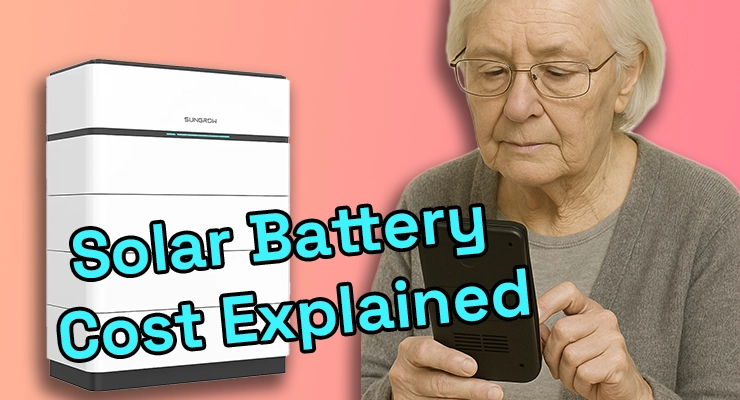Fast read
As of mid-2025, the fully installed price for a residential solar battery in Australia typically ranges from $9,000 to over $20,000. This cost is influenced by the battery's storage capacity, brand, inverter type, and installation complexity. A significant federal government rebate, the Cheaper Home Batteries Program, launches on 1 July 2025, and is expected to reduce upfront costs by providing a rebate of around $335-$372 per kWh.
What is the price range for a solar home storage battery?
Navigating the world of home energy storage can feel complex, with a wide array of products and prices to consider. As a homeowner in Australia, understanding the true cost of a solar battery is a critical step in deciding if it’s the right investment for your energy future. The price you see advertised is often just the beginning, with several key factors determining the final, fully installed cost.
This guide will walk you through the typical price ranges, what influences those costs, and the significant government incentives available that can make battery storage more affordable.
How much does a solar battery cost in Australia?
For a typical Australian home, a fully installed solar battery system in 2025 can cost anywhere from around $9,000 to well over $20,000. The most common residential battery sizes fall between 8 kWh and 15 kWh.
As a general rule, you can expect the cost to be between $1,000 and $1,200 per kilowatt-hour (kWh) of storage capacity, including installation. However, this cost per kWh often decreases as the battery size increases due to economies of scale—the core components and installation labour are shared across a larger capacity.
For example, a smaller 5 kWh battery might cost around $1,600 per kWh, while a popular 10 kWh battery, suitable for many households, generally falls in the $11,000 to $14,000 price bracket for a quality installation.
What factors determine the final price?
The final price you pay is a sum of several parts: the battery unit itself, the inverter, and the installation. Let’s break down what drives the cost in each of these areas.
- Battery Capacity (kWh): This is the most significant factor. The more energy a battery can store, the higher its price. It’s crucial to correctly size a battery for your home‘s energy consumption to ensure it’s a worthwhile investment.
- Brand and Technology: Premium and well-established brands often come with a higher price tag but may offer advanced features, better performance, and more robust warranties. For instance, a Tesla Powerwall 3 (13.5 kWh) has an estimated installed cost between $15,000 and $17,500. In contrast, a modular Sungrow SBR system will have a separate price for the battery and the required hybrid inverter.
- Inverter Type and Cost: A battery requires an inverter to convert the stored DC energy into AC energy that your home can use. If you’re installing a battery with a new solar panel system, you can use a single hybrid inverter for both, which is more cost-effective. If you’re retrofitting a battery to an existing solar system, you may need to purchase a separate battery inverter or upgrade your current one, adding to the overall cost. A quality hybrid inverter can cost between $2,200 and $4,500.
- Installation Complexity: The cost of labour from a Clean Energy Council (CEC) accredited installer can vary. A straightforward installation where the battery is placed next to the switchboard will be cheaper. Costs can increase if your switchboard needs upgrading, if extensive new wiring is required, or if the battery’s location is complex.
- Backup Functionality: Most people want a battery for backup power during a blackout. This requires extra components and wiring to isolate your home from the grid. With the Tesla Powerwall 3, while the solar inverter is integrated, it still requires a separate component called the “Gateway 3” to enable this function, which adds around $1,700 to the hardware cost. Some modern systems, like the Sigenergy SigenStor, integrate these components into a single unit, which can simplify installation.
Illustrative examples of popular battery systems
To make these numbers more concrete, here are a few examples of popular battery models and their estimated costs, keeping in mind that these can vary.
- Tesla Powerwall 3: With a usable capacity of 13.5 kWh, the Powerwall 3 has an estimated fully installed cost ranging from $15,000 to $17,500. It includes a built-in solar inverter, making it a streamlined option for new solar and battery installations.
- Sungrow SBR: This is a modular battery, meaning you can stack modules to create the size you need. A 9.6 kWh system has a hardware price starting from around $6,400, not including the required hybrid inverter and installation. Its flexible, scalable design is a key feature, allowing homeowners to start with a smaller capacity and add more later.
- Sigenergy SigenStor: This innovative system is an all-in-one unit. The hardware for an 8 kWh battery module is approximately $4,500-$4,900, but as an integrated system, the total hardware cost, including the required energy controller and gateway, is higher before installation.
Can government rebates lower the cost?
Yes, government incentives can significantly reduce the upfront cost of a solar battery.
The most significant is the federal Cheaper Home Batteries Program, which starts on 1 July 2025. This program is expected to provide a discount on the upfront cost of an eligible battery system. The rebate is calculated based on the battery’s usable capacity, offering approximately $335-$372 per kWh in 2025. For a typical 11.5 kWh battery, this could mean a saving of around $4,000.
Several states also offer their own rebates and loans that can often be combined with the federal incentive:
- New South Wales: The upfront installation discount under the Peak Demand Reduction Scheme ends on 30 June 2025 and cannot be combined with the new federal rebate. However, from 1 July 2025, an enhanced incentive for joining a Virtual Power Plant (VPP) is available and can be combined with the federal rebate. It offers up to $550 for a 10kWh battery, but note that this is a performance-based incentive often paid out over 12-24 months.
- Western Australia: A state rebate is available from 1 July 2025. For Synergy customers, it’s $130 per kWh (up to $1,300), and for Horizon Power customers, it’s $380 per kWh (up to $3,800). Critically, to be eligible for the rebate or an available interest-free loan of up to $10,000, households are required to participate in a VPP.
- Northern Territory: The Home and Business Battery Scheme offered a grant of $400 per kWh, capped at $5,000. The program has been fully allocated and closed to new applications as of early June 2025.
- Victoria: The Solar Homes interest-free loan program of up to $8,800 for batteries is now closed. Applications ceased in late May 2025 after all available program spots were filled ahead of the official 30 June 2025 end date.
- Australian Capital Territory: The Sustainable Household Scheme offers interest-free loans of up to $15,000 to help with the cost of batteries and other energy-efficient upgrades.
- Queensland: The Battery Booster rebate program for 2024 has closed and is not accepting new applications.
Is a home battery the right choice for you?
While falling prices and generous rebates are making batteries more financially viable, the decision ultimately depends on your goals. A battery can provide excellent value by reducing your reliance on the grid, lowering your power bills, and providing invaluable backup power during outages.
To determine if it’s the right fit, it’s essential to analyse your energy consumption patterns and get tailored quotes from accredited installers. If you need help navigating the options and finding a qualified professional, there are services that can connect you with trusted local experts who can provide clear, no-obligation advice for your specific needs.




